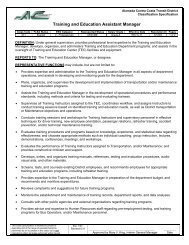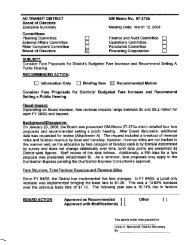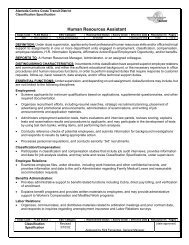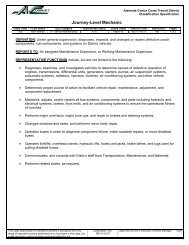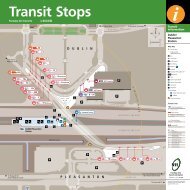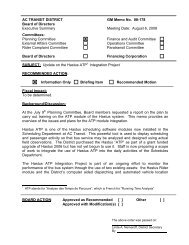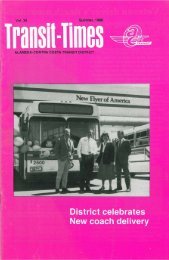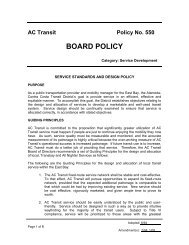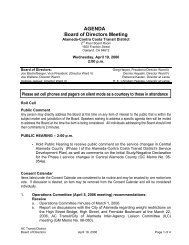Vehicle Use Policy - AC Transit
Vehicle Use Policy - AC Transit
Vehicle Use Policy - AC Transit
You also want an ePaper? Increase the reach of your titles
YUMPU automatically turns print PDFs into web optimized ePapers that Google loves.
<strong>AC</strong> <strong>Transit</strong> <strong>Policy</strong> No. 422BOARD POLICYCategory: Board andGeneral Administrative Matters<strong>Vehicle</strong> <strong>Use</strong> <strong>Policy</strong>PURPOSE:To establish the overall policies associated with the assignment and use of District nonrevenuevehicles. In adopting this <strong>Policy</strong>, it is the intent of the Board to minimize thenumber of directly-assigned non-revenue vehicles operated by the District and encouragethe concept of pool vehicles.POLICY:It is the general policy of the District that personal use of a District vehicle is not permittedexcept in cases where the District specifically authorizes or requires such personal use.The District specifically authorizes the use of vehicles for personal use only in those caseswhere an employee is subject to an employment agreement which includes the provision ofa District vehicle for the employee’s use. Other authorization of personal use will be asprovided in the Administrative Regulations implementing this policy.In addition, this policy establishes procedures for valuing the use of vehicles owned by theDistrict by employees for tax reporting purposes.The value of the personal use by an employee of a District vehicle generally is consideredadditional taxable wages (i.e., compensation for services) by the Internal Revenue Service(IRS). The value of the business use by an employee of a District vehicle is not consideredadditional taxable wages.Tax Reporting of Personal <strong>Use</strong> of <strong>Vehicle</strong>s for Control Employees. For purposes of taxreporting of personal use of District-owned vehicles, the IRS defines certain individuals as“Control Employees” under IRS Regulation section 1.61-21(0(6). “Control Employees” areelected officials or employees whose compensation level is at least as great as a Federalgovernment employee at Executive Level V (which for 2009 is $143,500). If an employeewho is provided the use of a District vehicle under an employment agreement is a ControlEmployee, then the District will utilize valuation methods (not including the “commuting rule”described in Section 4.1 of the Procedures below) that are authorized by the IRS forreporting the value of the personal use of the vehicle and will report the value asdetermined in accordance with the Procedures contained in this <strong>Policy</strong>.Page 1 of 5 Adopted: 10/10/90Amended: 10/28/09
Tax Reporting for Non-Control Employees with Employment Agreements Using theIRS “Commuting Rule.” If an employee who is provided the use of a District vehicleunder an employment agreement is not a Control Employee, then the District requires thatsuch employee commute to and/or from work in the vehicle for a valid non-compensatorybusiness reason, and that the employee not use the vehicle for personal use other thancommuting (except as incidentally allowed under the IRS rules related to use of the“commuting rule”). In such case, the value of the use of the vehicle for the requiredcommuting will be reported for tax purposes as provided under Section 4.1 of theProcedures contained in this <strong>Policy</strong>.Tax Reporting of Personal <strong>Use</strong> of <strong>Vehicle</strong>s for All Other Employees. Unlessspecifically authorized in accordance with the Administrative Regulations implementing this<strong>Policy</strong>, use of District vehicles for personal use is not permitted. To the extent required byIRS regulations, the value of personal use of a District vehicle will be reported to the IRS inaccordance with the Procedures below.All employees must submit the required documentation described in the Procedures belowregardless of the valuation method used to report to the IRS.PROCEDURES:1. Business vs. Personal <strong>Use</strong>.1.1 Business <strong>Use</strong>. Business use of a District vehicle is any use for official Districtbusiness. Business use of a District vehicle includes (but is not limited to):(a) Travel between the employee’s main or regular place of work andanother regular place of work;(b) Travel between the employee’s main or regular place of work and atemporary work location; and,(c)Travel between the employee’s home and a temporary work location.1.2 Personal <strong>Use</strong>. Personal use of a District vehicle is any use that is not forofficial District business. Personal use of a District vehicle by an employee includes (but isnot limited to):(a) Commuting, i.e., travel between an employee’s home and his or hermain or regular place of work (see Section 2.3, Commuting, below);(b)location; and,Using the vehicle to run a personal errand from the employee’s workbusiness.(c)Using the vehicle on weekends or days off for other than official DistrictPage 2 of 5 Adopted: 10/10/90Amended: 10/28/09
1.3 De Minimis Nontaxable Personal <strong>Use</strong>. Certain limited personal use of avehicle that is only available for business use, such as a pool vehicle, may be consideredde minimis by the IRS and not subject to reporting or taxation. Examples of de minimisnontaxable personal use include:(a) Infrequent (not more than one day per month) commuting in Districtvehicle (infrequent, occasional situations); such as when an employee has a late meetingand drives a pool vehicle home and returns the vehicle by commuting to work the next dayand returning the pool vehicle at that time;(b) Small personal detour while on business, such as driving to lunchwhile out of the office on business.Note: Substantiation of use of the District vehicle by the employee is required in order todetermine if the IRS requirements for de minimis use have been met.1.4 Commuting. One of the most common personal uses of a District vehicle iscommuting, defined as an employee’s traveling between home and his/her main or regularplace of work. Personal commuting between the employee’s residence is personal useregardless of whether it is required by the District.Travel that meets the above definition of commuting does not change from personal use tobusiness use of the vehicle if the employee works during the commute; for example,making business phone calls or holding business discussions with co-workers who aretraveling with the employee. Also, transporting District equipment or District records ordocuments in the vehicle while commuting does not convert the trip from personal tobusiness use.(a) Second Work Location. If an employee regularly works at two ormore locations in one day, traveling between the two locations is a business use of thevehicle. However, traveling between the employee’s home and any of his/her regular worklocations is commuting, a personal use of the vehicle.(b) Temporary Work Location. An employee’s traveling between homeand a temporary work location is a business use of the vehicle rather than commuting. Analternate work location is temporary if it is realistically expected to (and does in fact) last forone year or less. An alternate work location is not temporary if it is realistically expected to(or does) last more that one year, or if employment at the location is indefinite.2. Substantiating Business and Personal <strong>Use</strong>. The IRS requires the District tomaintain documentation that substantiates an employee’s business and personal use of aDistrict vehicle. When such records are maintained, the District is required to report to theIRS only the value of the personal use of the vehicle as additional taxable wages. If suchrecords are not maintained by the District, the entire value of the employee’s use of thevehicle (including both business and personal use) is considered personal use and must bereported as additional taxable wages to the IRS.2.1 Example. Assume the value of the use of a particular District vehicle for onePage 3 of 5 Adopted: 10/10/90Amended: 10/28/09
year is $10,000. An employee uses the vehicle 90% for official District business and 10%for personal use (e.g., commuting) during that year.(a) If the employee provides the District with the required documentationto substantiate this allocation of business and personal use, $1, 000 must be reported asadditional taxable wages.(b) If the employee does not provide the required documentation, theentire value of the employee’s use of the vehicle or $10,000 must be reported as additionaltaxable wages.2.2 Required Documentation. Each employee who uses a District vehicle, foreither business or personal use, must submit to the District a written record of such usemade at or near the time of the use of the vehicle, e.g., a log, account book, diary, tripsheet, or similar record. The record should include the date of the trip, a brief description ofthe purpose of the trip, the number of miles driven for business use, and the number ofmiles driven for personal use.3. Income Tax Reporting and Withholding. The District reports as taxable wages thevalue of the personal use of a District vehicle to the IRS, the state and the employee onForm W-2, Wage and Tax Statement to the extent required. The District will implementappropriate withholding procedures on this additional compensation, as required, from theemployee’s regular pay.4. Valuation of Personal <strong>Use</strong>. The District must determine the value of the personal use ofthe District vehicle in order to report this amount as additional wages on the employee’s W-2. Based on IRS regulations, there are a number of methods that can be used to determinethe value of the vehicle provided to the employee: commuting rule (commuting is valued at$1.50 each way), cents-per-mile rule, general valuation, and annual lease value. TheDistrict has determined that, wherever possible, the commuting rule will be used todetermine the value of the vehicle provided. Where the commuting rule is not applicable,the District will use one of the other valuation methods that it determines is mostappropriate.4.1 Commuting Rule. The commuting rule places a value of $1.50 per one-waytrip between the employee’s home and regular or alternate place of work. In order to usethe commuting rule, the following requirements must be met:(a)(b)The District must own or lease the vehicle;The vehicle is provided to the employee for business use;(C) The District requires the employee to commute to and/or from work inthe vehicle for a valid non-compensatory business reason;(d) The District has a written policy prohibiting personal use of the vehiclesother than for commuting;Page 4 of 5 Adopted: 10/10/90Amended: 10/28/09
(e) The employee generally does not use the vehicle for personalpurposes other than for commuting (minimal personal use is permitted); and,(f) The employee is not either an elected official or an employee whosecompensation is equal to at least $143,500.4.2 Other Valuation Methods. The remaining valuation methods (cents-per-mile,general valuation, and annual lease value) compute the value of an employee’s use of aDistrict vehicle on the ratio of personal use of the vehicle to the employee’s total use of thevehicle. Each method has its own requirements which the District will take intoconsideration in determining which method to use.4.3 Reporting Period. Under the Procedures established under this <strong>Policy</strong>, thereporting period for personal use of District vehicles begins on November 1 and ends onOctober 31, a full 12-month period. The District defers reporting of vehicle use income forNovember and December of a given year until it files its reports for the subsequent year.Example: Income from the personal use of a District vehicle during the periodNovember 1, 2009 through October 31, 2010 is reported as additional taxable wages on anemployee’s 2010 Form W-2. The value of vehicle use during November and December2010 is reported on an employee’s 2011 Form W-2.4.4 Requirement for Documentation. Employees must submit the requireddocumentation described above regardless of the valuation method used for reporting tothe IRS. (For example, even for employees subject to the “commuting rule” described in 4.1above, documentation of the number of one-way trips will be required.)5. Reimbursement For <strong>Use</strong> of Personal <strong>Vehicle</strong>s. Employees who use theirpersonal, non-District, vehicle for the performance of District business shall be entitled tomileage reimbursement as provided for in the IRS Regulations as they may be amendedfrom time-to-time.IMPLEMENTATION:The General Manager shall issue any and all necessary Administrative Regulations toimplement the above <strong>Policy</strong> and Procedures, including the issuance of directives relating tovehicle assignments, use of general pool vehicles, operating limitations, service andmaintenance standards, and reporting of accidents involving District vehicles. In issuingthe Administrative Regulations the General Manager authorization to assign an employee aDistrict owned, non-revenue vehicle for 24-hour use shall only occur in those situationswhere a written justification for such an assignment occurs and a record of that justificationis available for public review. At least semi-annually during each fiscal year the GeneralManager shall provide the Board with a written report identifying the number of Districtowned, non-revenue vehicles in existence, the departments to which they are assigned,how many are available to an employee on a 24-hour basis and such other information asthe Board may from time-to-time request.Page 5 of 5 Adopted: 10/10/90Amended: 10/28/09




